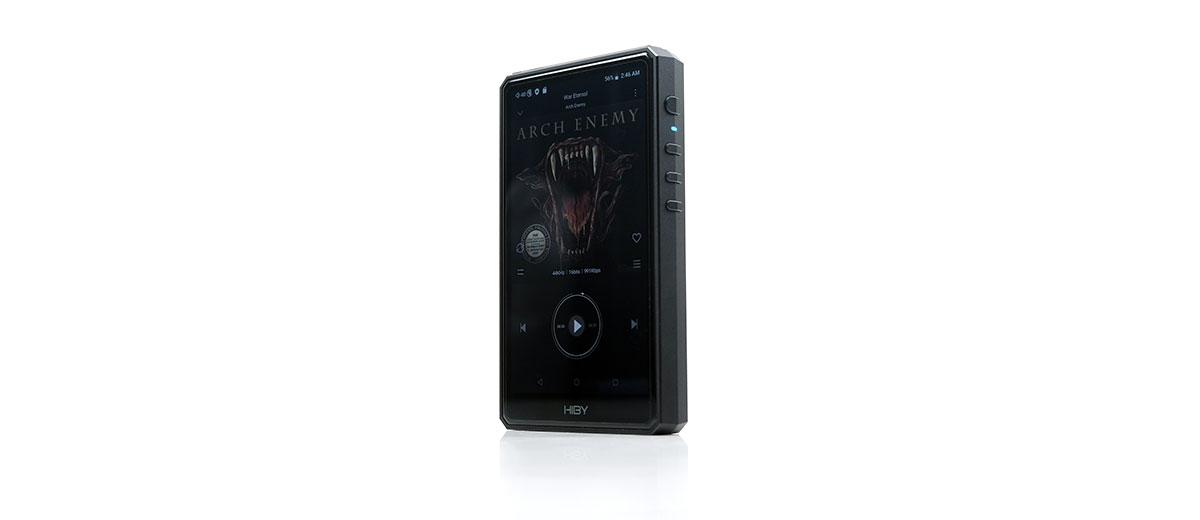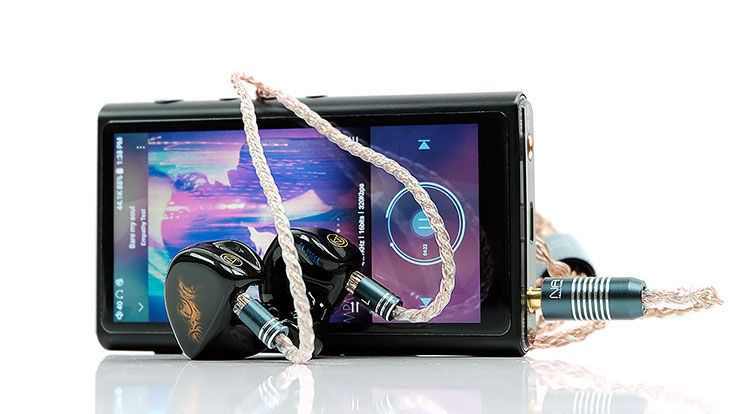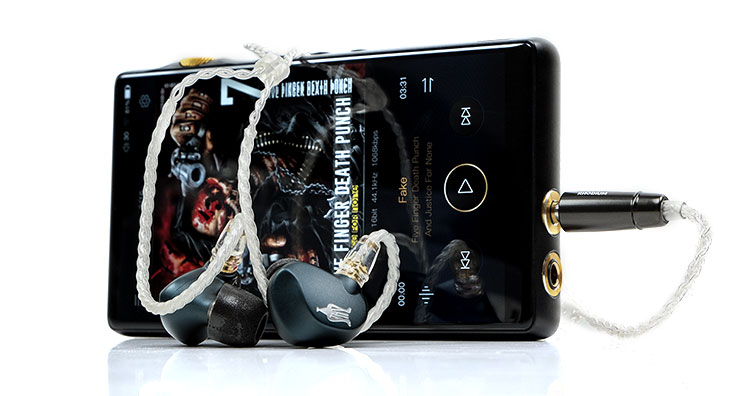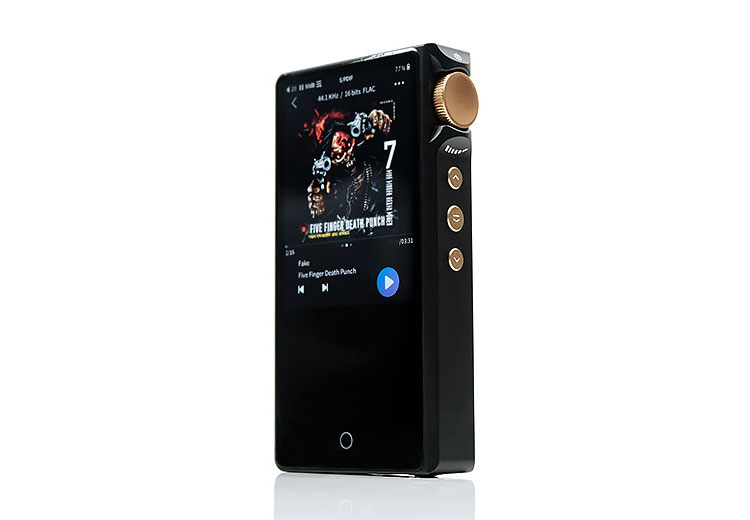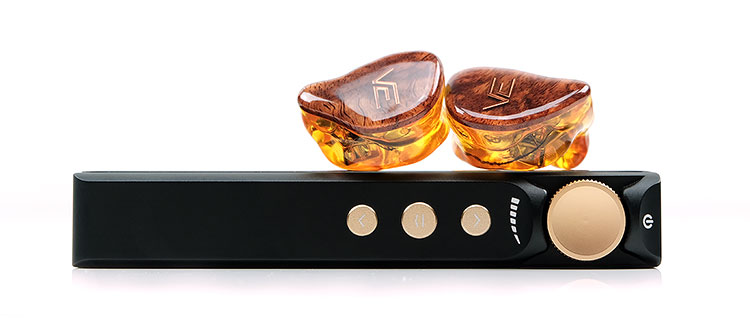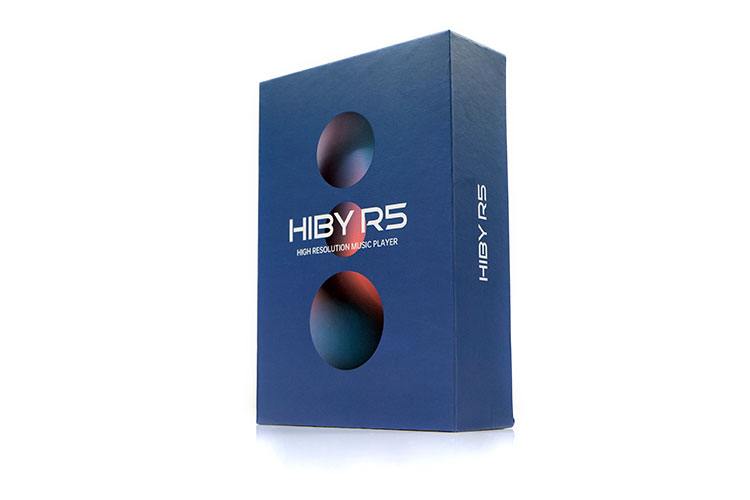Select Comparisons
All comparisons were completed using Class A mode with a mix of IEMs including the qdc Dmagic 3D, Empire Ears Bravado MKII, and the 64 Audio Duo. For headphones, the Sennheiser HD660S with a balanced 4.4mm Chord Company cable was used.
HiBy R5 Gen 1
$399 (discontinued)
The original edition rather than the Saber version which James reviewed last year. You can read our review of the Gen 1 R5 in more detail here.
Technical
Inside, both are dual DAC but the original packs the older, yet quite popular, CS43198 chipset as opposed to the somewhat newer ES9219C Saber inside the R5 Gen 2. Both DAC designs are primarily stereo low-energy resources so ideal for a mobile battery type solution such as a DAP.
The decoding rates are indeed better on the R5 Gen 2 with rates of up to DSD256, PCM 32BIT/768kHz, and 16X MQA decoding capability. The original R5 is still listed as offering similar native DSD decoding at DSD256 but a lower PCM rate of 32/384kHz and half the MQA unfolding capability at 8X.
Both have the same Snapdragon 425C CPU, the same 2GB of data, and also similar Android 8.1 OS implementations. On the surface, that might seem somewhat disappointing but the larger housing of the R5 Gen 2 and what seems to be better thermal protection means far less heat, less thermal throttling, and generally a better performance from our measurements.
The big deviation, however, is the amping section. The R5 Gen 1 offers one route and it is an IC topology consisting of two AD8397ARDZ chips offering up to a maximum of 564mW balanced and 148mW unbalanced into a 32Ω load.
The R5 Gen 2 offers a dual operational mode amplification topology with a direct DA-to-amp based on the ES9219C DAC chipset called Economy mode. The second is a far higher-end Class A push-pull discreet design which should be the go-to for anyone interested in this DAP.
You do get a slight drop in maximum power at 32Ω with its 475mW output rating if you chose balanced but the R5 Gen 2’s improved voltage handling in Class A for higher load headphones should be superior.
Design
The original is far more compact and a little lighter. I know some will probably think that is an advantage over the heavier and bulkier R5 Gen 2 but it’s actually not. There are a few reasons for that.
The first is heat management. The inside of the R5 simply gets too hot for the small chassis to dissipate it properly causing a slow down in the CPU functionality and at times in stress testing, it rebooted due to overheating.
The second is Android as an OS which really does not suit a 4″ screen that well. The increase to 4.7″ for the R5 Gen 2 may not seem much on paper but it’s a massive increase in useability in real-world testing. You can type better, scroll a bit less, see more media, the list goes on. We like our phones big these days so a larger DAP is culturally acceptable.
The R5 Gen 2 still shares a lot of design features from the Gen 1, however, it just looks better than before. That includes digital +/- volume buttons on the left panel, a single MicroSD slot, same onboard 16GB of memory, and a USB-C for all your digital I/O.
What it adds is more balanced analog output options for 2.5mm TRRS and 4,4mm Pentaconn which suites audiophiles more in this day and age. It also adopts the design language of the R6 series and R8 DAPs which has a more minimalist modern look.
Battery life differences are dependent on the R5 Gen 2 amplifier mode. On Class A it is way down on the R5 Gen 1 at around 7 -10 hours compared to the standard 15 hours on the original. However, in economy mode, it’s double at 30 hours on the R5 Gen 2.
Performance
A couple of timbral differences and some striking technical differences, particularly if you plan on using heavier loads like the HD660S.
With the qdc Dmagic 3D, which is a triple dynamic driver IEM, the R5 Gen 1 sounds cleaner and more neutral in its imaging compared to the R5 Gen 1 which is d more bass and vocal forward but narrower in its staging.
The Gen 1 is more relaxed and warmer sounding which might suit those more sensitive to treble, but to my ears, the R5 Gen 2 is not that treble sharp despite obviously having more treble presence. What it changes is the complexity in the staging, offering more width and air with the dMagic 3D and better instrumental separation throughout.
The R5 Gen 1 is excellent for depth and power and here it shades the Gen 2 for weight but also creates a little more bloom compensated by that intimate and forward vocal delivery. The R5 Gen 2 is more balanced, not as warm on the lows but does sound tighter and more articulate.
You could argue the R5 Gen 2 is more resolving in Class A mode given its treble performance casts a better light on higher frequency instruments and creates a better sense of space for delicate notes to shine.
The technical difference becomes a lot more obvious once you plug the HD660S into both R5 DAPs. The original sounds relatively congested, slightly veiled, and struggling to punish out beyond that narrower soundstage. It still has some nice weight but it’s a softish tone with a more compressed midrange.
The R5 Gen 2 is much cleaner, more dynamic sounding, pushing out wider and holding a very steady and clear image, particularly in the mids which offer some pleasing depth to the instrumental placement.
iBasso DX160
$499
The compared sample here is the original 2019 version. Thus options such as the CTIA compliant 3.5mm SE jack port are not available and it uses the older Sharp IPS panel compared to the new JDI version. You can read our full review of the DX160 here.
Digital Technical
The DX160 came out around the same time as the original R5 and there must have been some love-in with CS chips at the time because it also uses a dual Cirrus Logic CS43198 DAC implementation as opposed to the R5 Gen 2’s ES9219C design.
Decoding is on par with the original R5 and the R5 Gen 2 for DSD at a native DSD256 capability but also slightly behind the newest R5 for PCM at 32BIT/384kHz as opposed to 768kHz. MQA is also lower at 4X as opposed to HiBy’s much more impressive 16X capability.
Both digital implementations do include bitperfect output at a system-wide level though iBasso’s world-class PMEQ system is restricted to the Mango app whereas HiBy’s unique MSEB can be applied outside of their own specific apps.
The two DAPs do offer wireless connectivity with WiFi and BT which means you can receive up to LDAC 24BIT/96kHz. The DX160 does support BT5.0 which is a grade higher than the BT4.2 inside the R5 Gen 2 though for many that might not make a huge difference.
Both devices use Android 8.1 and 2GB of RAM, however, the DX160 uses a lower-tier ARM Cortex chipset which is much slower than the R5 Gen Snapdragon 425 SoC. You can see the difference easily in terms of the R5 Gen 2’s faster touch response, cooler CPU temp, and smoother scrolling.
Analog Technical
The DX160 only has one amplification mode rather than dual but it is a balanced topology with both 4.4mm TRRS and 3.5mm TRS output options. It does not have the R5 Gen 2’s additional 2.5mm TRRS balanced PO option. Both DAPs do I/O a shared 3.5mm PO/LO so not a true lineout from either unit.
iBasso used to make it tricky for a side-by-side comparison of amping power. Only in the last year have they standardized for A-weighting on loads instead of unloaded Vrms. HiBy has provided Vrms ratings for both their economy mode and Class A mode but these seem to be weighted for 32Ω loads rather than unloaded so still not a like for like.
The DX160 is capable of up to up to 6.4Vrms balanced via its 4.4mm analog out unloaded and with a 32Ω load the HiBy maxes out at 3.9Vrms using its Class A balanced output. Difficult to compare and comment on but given the DX160 is not a Class A topology you would expect the R5 Gen 2 to handle higher loads more efficiently.
Design
I cannot fault iBasso for just how slim the DX160 is in the hand. Even compared to the R5 Gen 2 is much thinner and lighter at 178g compared to 220g.
It has even managed to throw in a high-end 5″ IPS 1080p capable panel which is slightly larger than the 4.7″ 720p panel of R5 Gen 2. All whilst keeping those bezels to an absolute minimum making it a small form factor but with a larger screen. Very hard to match that on a physical level.
However, the R5 Gen 2’s heat management system and better CPU are far superior. Its stays cooler compared to the toasty DX160 which might suggest there is simply not enough room inside the DX160 for it to vent. Combine that with the older and slower CPU and you get more throttling and a laggy response from that great screen.
The battery life of both is again dependent on the R5 Gen 2’s amp mode. If you opt for Class A then that 7-10 hour rating is easily beaten by the DX160’s 13 hour life span. If you go for economy mode then the R5 Gen 2’s 30 hours rating is pure monster and top of the class. Both do offer quick charging capability so there is no difference there.
One advantage the Dx160 does have is onboard memory at 32Gb compared to just 16GB on the R5 Gen 2. You can expand both via memory cards with single slots and both have OTG flash drive capability also.
Performance
The DX160 matches the R5 Gen in terms of stereo channel separation and staging width. It also cast a very airy and clean top end, perhaps brighter also than the R5 Gen which, in comparison, has a slight attenuation in presence and forwardness, particularly in the upper mids and lower treble of our tested monitors.
On the flip side, the R5 Gen 2 hits deeper and sounds the more fulsome through the lows and mids. The DX160 can sound punchy but comparatively sub-bass light pushing the ear more towards a brasher vocal and upper mids delivery.
Here the vocal imaging is a shade further forward on the DX160 with more odd harmonic presence whereas the R5 Gen 2 is richer and fuller sounding but not quite as forward.
If you are using a pure dynamic driver monitor such as the Dmagic 3D I think the difference is starker in terms of the snap and weight of the bass. Empire Ears Bravado MKII will also produce the weightier response of the two DAPs when paired with the R5 Gen 2.
For headphones, it is much the same situation although the Dx160 definitely holds its own in terms of a strong central image and airiness on the highs. I have no issues with either in terms of being able to deliver a wide staging quality.
Where the R5 Gen 2 has an edge in Class A mode is the depth and power which is more convincing and adds an additional dimension to the performance of the HD660S.
Cayin N3PRO
$479
The Cayin N3PRO was our bang for buck DAP award winner from 2020. You can read our full review in more detail here.
Analog Technical
This is a completely different experience but on some level, there is some shared thinking. The shared thinking is focused on the flexibility of the amplification operational mode though, for me, the N3Pro’s approach is a bit more complex.
Instead of an entirely solid-state switchable operational mode, the N3Pro offers both a solid-state and a Vacuum tube amplification option with a matched pair of Raytheon JAN6418 mini pentode tubes.
However, you can only acquire the vacuum tube option in SE mode output as it is a single-ended topology whereas the R5 Gen 2 can offer both economy mode and Class A mode via both SE and balanced outputs.
The complexity area is in the amplification tuning and here the N3Pro offers a switchable operational mode for the vacuum tube option with ultralinear and triode timbre options. The solid-state mode has but one flavor.
The R5 Gen 2 does not have timbral switches but you can tell an immediate difference between the Class A and economy mode as well as access to a system-wide MSEB DSP for further and more extreme flavoring of the output.
In terms of power, The N3Pro has more of it at 800mW max balanced and 250mW unbalanced into a 32Ω load. However, 0.002% and 0.003% THD+N for unbalanced and balanced output respectively, it carries a bit more noise and distortion than the R5 Gen 2.
Digital Technical
Both DAPs are dual DAC, however, Cayin opted for dual AKM AK4493EQ as opposed to HiBy’s ES9219C chipsets. The AKM chipsets are much harder to get these days with Cayin themselves opting for Rohm and R2R on some of their latest creations.
Local playback and USB-DAC capability on the N3Pro are set at DSD256 (Native), DSD128 (DoP), and 32BIT/384kHz PCM which is a bit lower than the R5 Gen 2 at DSD256 and PCM 32BIt/768kHz.
However, the N3Pro does have a USB Audio-out capability of 32BIT/768kHz PCM as well as up to DSD512(Native), DSD256 (DoP), and PCM 88.2kHz (D2P) when in transport mode. Like the R5 Gen 2, it also offers MQA unfolding but I believe X4 or X8 but not X16.
Both DAPs are equipped with BT and wireless capability and can also offer up to LDAC 24BIT/96kHz for transmission and receiving. However, the N3PRO is BT5.0 as opposed to BT4.2 for the R5 Gen 2.
Design
Very different looking DAPs with the N3Pro a bit thicker but also narrower and of the two, maybe 1-2mm shorter. It is also a little bit lighter than the R5 Gen 2 at 192g compared to 220g.
Of the two, the N3PRO is slightly easier in the hand with all controls on the right panel including a multifunctioning rotary dial for volume and power. The R5 Gen 2 can require two hands at times given the volume is on the left panel and the controls are on the right panel.
No doubt the R5 Gen 2 screen in terms of resolution and real estate is the better of the two. The N3Pro’s smaller 3.2″ IPS panel is optimized for its walled HiBy OS but even so, it is much heavier on the scrolling and not as easy to use.
The R5 Gen 2 Android might not be the latest and greatest but it offers much more expandability for streaming, local playback media management, and of course those all-important apps. If you need options, the R5 Gen 2 is the only game in town for this comparison.
The N3Pro also does not come with any onboard memory unlike the 6Gb inside the R5 Gen 2 but both have microSD slots and OTG flash memory capacity for expansion. Wireless on the N3Pro is strictly limited to OTA firmware updates.
Solid-State Performance
Starting with the solid-state versus solid-state, the N3PRO’s AKM credentials shine through here with a little more punch and explosiveness on the low-end whereas the R5 Gen 2 reaches deep, possibly even deeper into the sub-bass region but stays marginally flatter for overall punch.
Conversely, with the 64 Audio Duo, the SS mids of the N3Pro, particularly the vocals seem a little lighter in body and pull a touch more from the lower treble. I would not say brighter but a little sweet and cleaner whereas the R5 Gen 2 sounded richer and smoother.
Imaging-wise, the N3 Pro vocals, and upper mids are a shade further forward but bass to lower mids seems to offer more separation using the Duo and the Dmagic 3D. The R5 Gen 2 delivers a smoother more balanced bass to mids transition with less upper mids energy but with better support for lower-mids weight and presence.
Tube Performance
On the tube side, it’s a totally different experience. Using the Ultralinear mode on the N3Pro vocals are much further forward and sweeter sounding with a very airy and expansive mids and treble tuning. The N3Pro tube ultralinear mode is perfect for the 64 Audio Duo’s airy presentation.
It is not quite as powerful or as deep as the R5 Gen 2 with our tested monitors but it really brings you into the vocal experience with a euphonic overtone and plenty of staging width.
The R5 Gen 2 will sound the more solid-state here and perhaps a lot more precise also with a more linear and neutral delivery. Vocals are less to the fore but bass to mids are firmer whereas the Ultralinear mode of the N3Pro shaves a bit of weight off in comparison.
The Triode mode is relatively relaxed and narrower sounding in comparison. The bass punch is still good but not quite as solid as the R5 Gen 2 low-end performance with our test monitors. Vocals are sweeter sounding as you might expect with a generally more ethereal presentation compared to the R5 Gen 2’s thicker Class A sound.
Our Verdict
The HiBy R5 Gen is a very welcome addition to what has become a somewhat sparse-looking $500 and below DAP market in 2022.
You need an edge these days, something unique or easily defined to make your digital player stand above the swarm of dongles nipping at your toes. The Class A mode of the R5 Gen does exactly that and to be frank it’s the only mode you need with the lesser Economy mode really more of a backup to get to that very impressive 30-hour battery life.
It is not just about power and its tuning performance. Some of the bread and butter features from the original R5 are also improved upon. The larger body is not just for the bigger IPS and Android presentation but also helps cool the unit much better than older generation DAPs of a similar size or smaller.
I would have liked to have seen Android 10, with more RAM and memory for a speedier UI but given the costs of things in 2022, I suspect that was not compatible with the price point HiBy was going for.
Instead, you get a very rounded mid-budget Android DAP with an excellent Class A output performance that mixes very well indeed with a wide range of IEMs and importantly for some, higher load dynamic driver headphones.
HiBy R5 Gen 2 Specifications
- Operating system Android 8.1
- SoC model Snapdragon 425
- DAC ES9219C x2
- WiFi Supports 2.4GHz, 5GHz
- Bluetooth Bluetooth 4.2
- USB USB 2.0
- Display size 4.7”, Display type IPS, Display resolution 720*1280
- RAM 2GB, Internal storage 16GB, Micro SD card <2TB
- Color Black
- Body material Aluminum
- Dimensions 123*71.3*15.5 mm, Weight 220 g
- Input 5V⎓0.5A or 9V⎓1.5A
- Battery capacity 4500mAh, Charging time Approx. 2h (0%-100%)
- Firmware upgrade Over-the-air internet-connected upgrade
- Third-party app installations Unlimited

